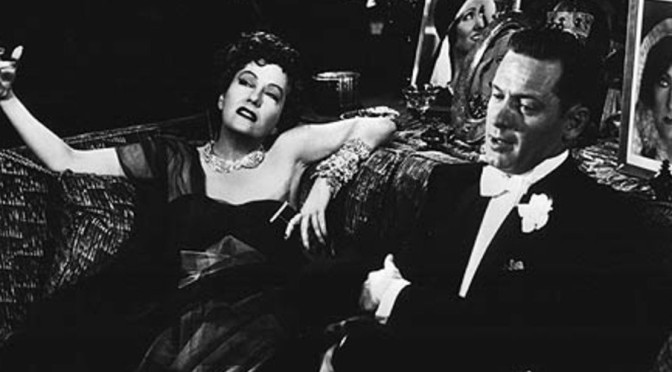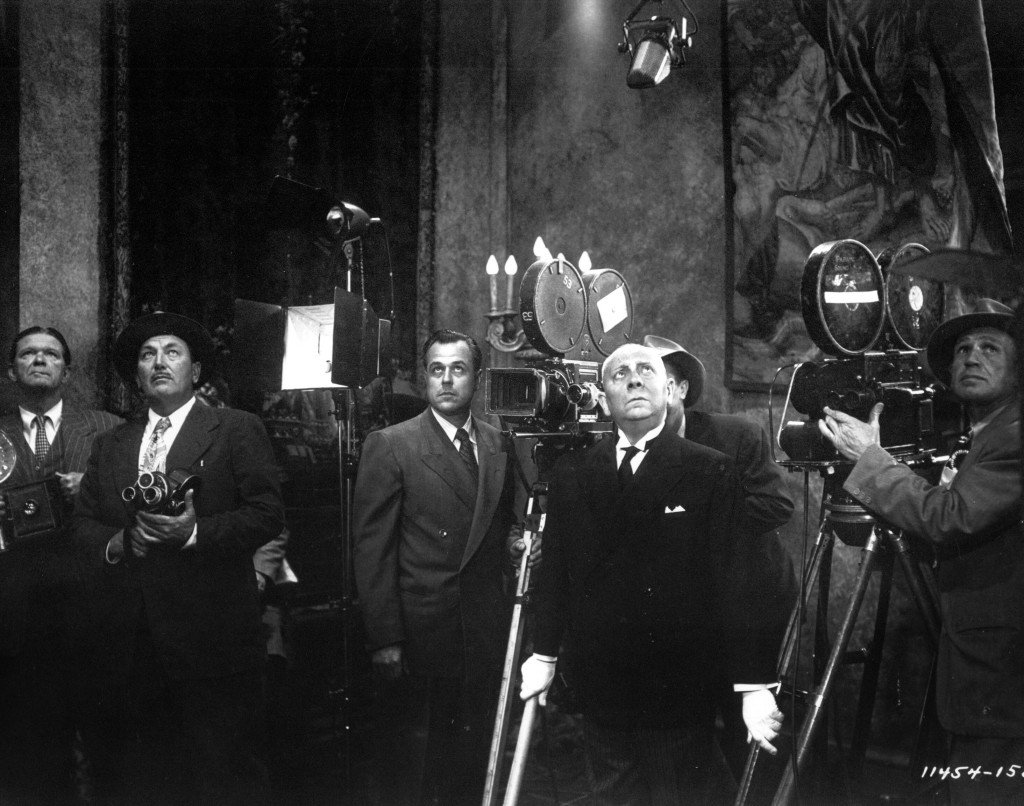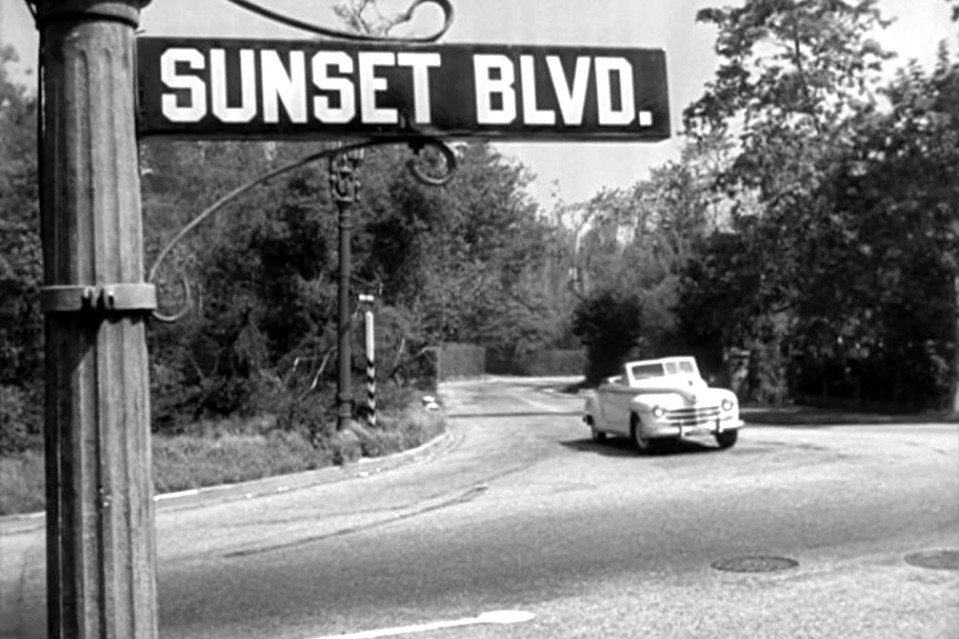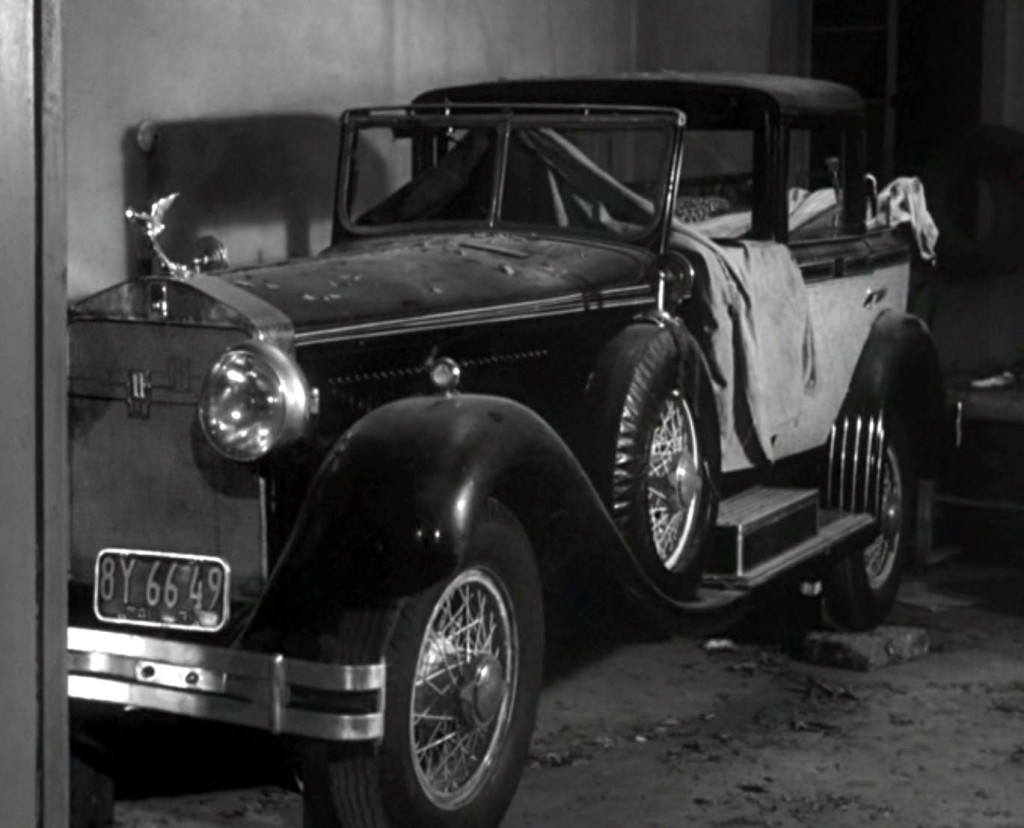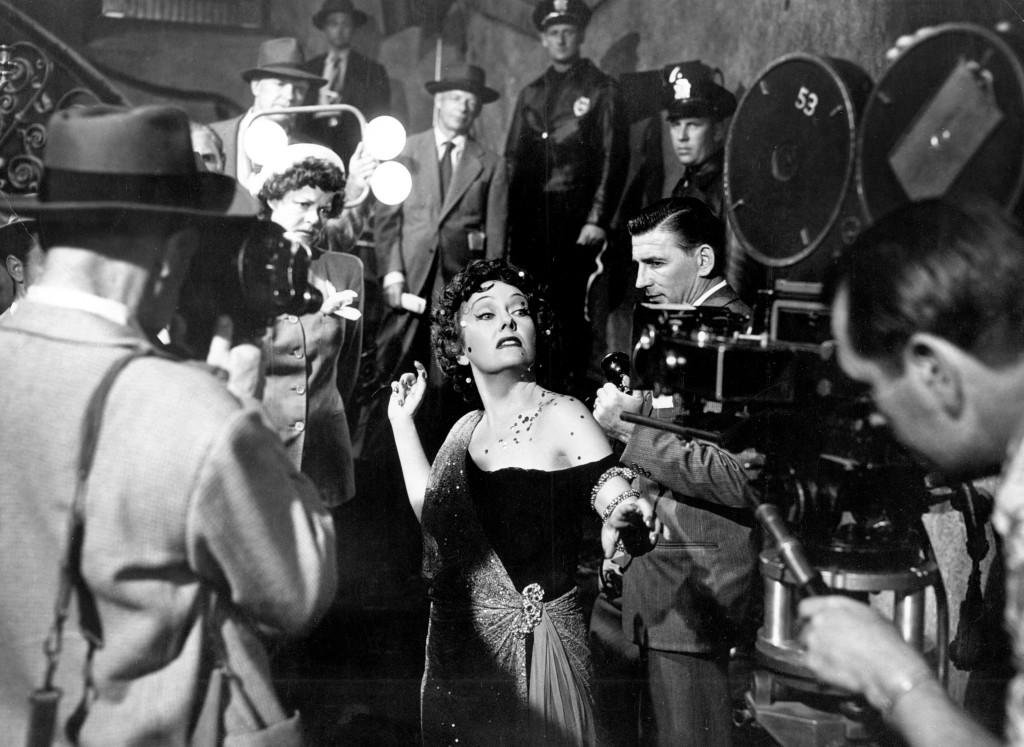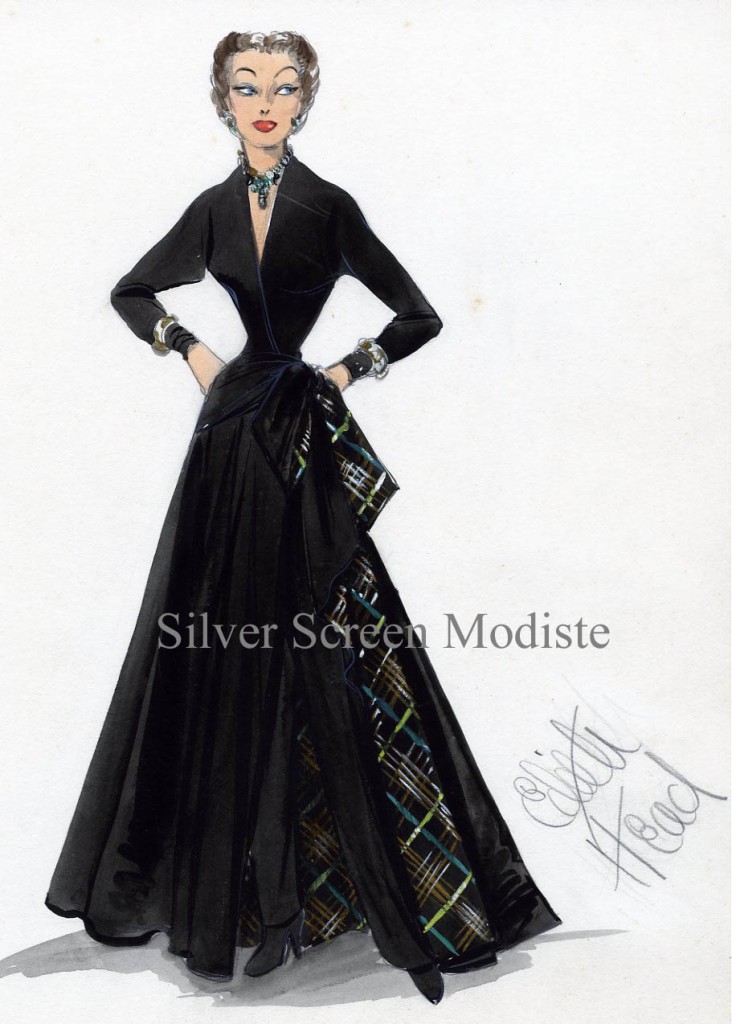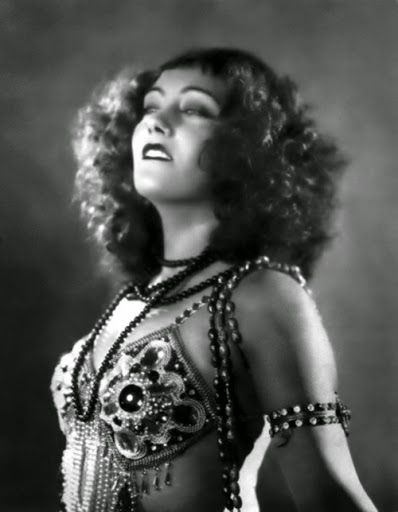The classic movie about Hollywood, Sunset Blvd, is approaching its 65th anniversary. It premiered at the Radio City Music Hall on August 10, 1950, where it shattered non-holiday attendance records. For a film noir about 1950 Hollywood, reflecting on a fading 1920s era movie star, it’s amazing that it has remained so relevant. That it has is thanks to the acting and directing – which were outstanding. But it’s the writing that’s sublime. the writing in combination with that great character Norma Desmond.
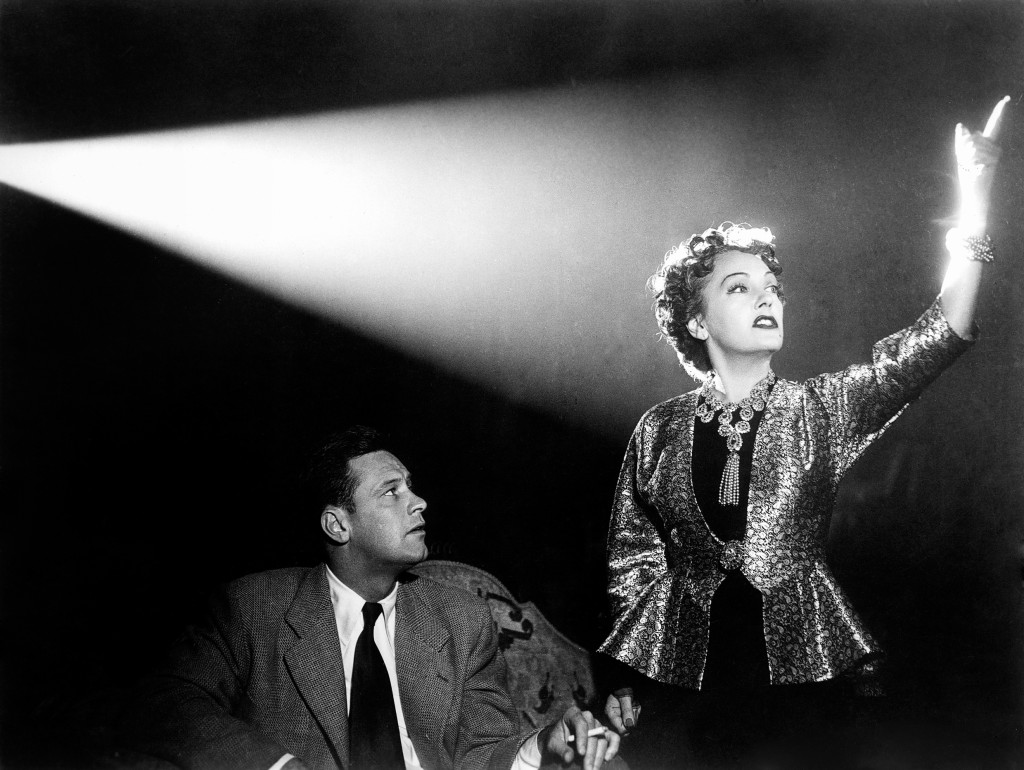
The story of faded glory, youthful ambition, and desperate attempts to hold on to to the Hollywood dream is forever being relived. The script by Charles Brackett and Billy Wilder makes a great story of Hollywood’s long past and eternal present, but it’s the one-liners that pepper our vocabulary today. “All right Mr. De Mille, I’m ready for my close-up,” says Gloria Swanson as Norma Desmond. Earlier in the movie, reflecting on her silent films, she said, “We didn’t need dialogue, we had faces,” and “I am big, it’s the pictures that got small.” And indeed, William Holden as Joe Gillis is more transfixed by Norma Desmond herself in the scene above, rather than in the movie she shows him. Sunset Blvd. continually reflects on itself and on Hollywood history, a hall of mirrors for old movie fans. In the photo above, Norma Desmond shows Joe Gillis a film in which she starred – when she was big. The movie shown is Queen Kelly. Wilder had a wicked sense of humor, Queen Kelly is the movie that made Swanson not so big. She lost a fortune on this self-produced film, never even released in the U.S. due to its outlandish content. She never fully recovered.
Below Erich von Stroheim playing Max the butler is “directing” her final “scene”, since in the story he was once her director, and who in Hollywood really was once her director. For the scene Gloria Swanson is dressed as Salome, whose part she once really played, descending the staircase to the theme music from The Dance of the Seven Veils. The director of that movie, Queen Kelly, had been Eric von Stroheim. who Gloria Swanson had fired.
The team of Billy Wilder and Charles Bracket both wrote the script and produced the film for Paramount Pictures. The idea of a Hollywood-themed movie had come to them, one primarily focused on a faded star with hopes of a comeback. The idea of a younger, hungry scriptwriter was a natural fit. The actress to play the role was crucial. Which one, they debated? Greta Garbo perhaps, although she would never consent. Then there was Mary Pickford – uninterested. Perhaps Pola Negri, who was big, but now living as a recluse. Mae West was considered, but didn’t quite fit the image they had in mind, and likely to want to re-write the script. Gloria Swanson was finally considered, the one star that really was considered royalty on the Paramount lot back in the 1920s. Indeed, she married into French aristocracy in 1925 and became the Marquise de la Falaise de la Coudraye. Gloria read the script, such as it was early in its draft form in 1949, and agreed to play the part. She was taken aback, however, when she got a call from the Paramount casting director wanting her to take a screen test. “Without me there would be no Paramount Studio!” one can imagine her shouting, as did Norma Desmond in the movie.* But Gloria was somewhat more complacent, saying she had made two dozen pictures for Paramount. Why the need for a screen test? Neither the casting director nor Billy Wilder told her that after all those years away from making movies, they wanted to see how old she would look on film, and what presence she had on screen. But as it turned out, they would actually have to use makeup to make her look older, but she still had the old magnetism.
As for the role of Joe Gillis the young screenwriter, Montgomery Clift was offered the part, but backed out of the production at the last minute. It seems he didn’t want the role of making love to an older woman.
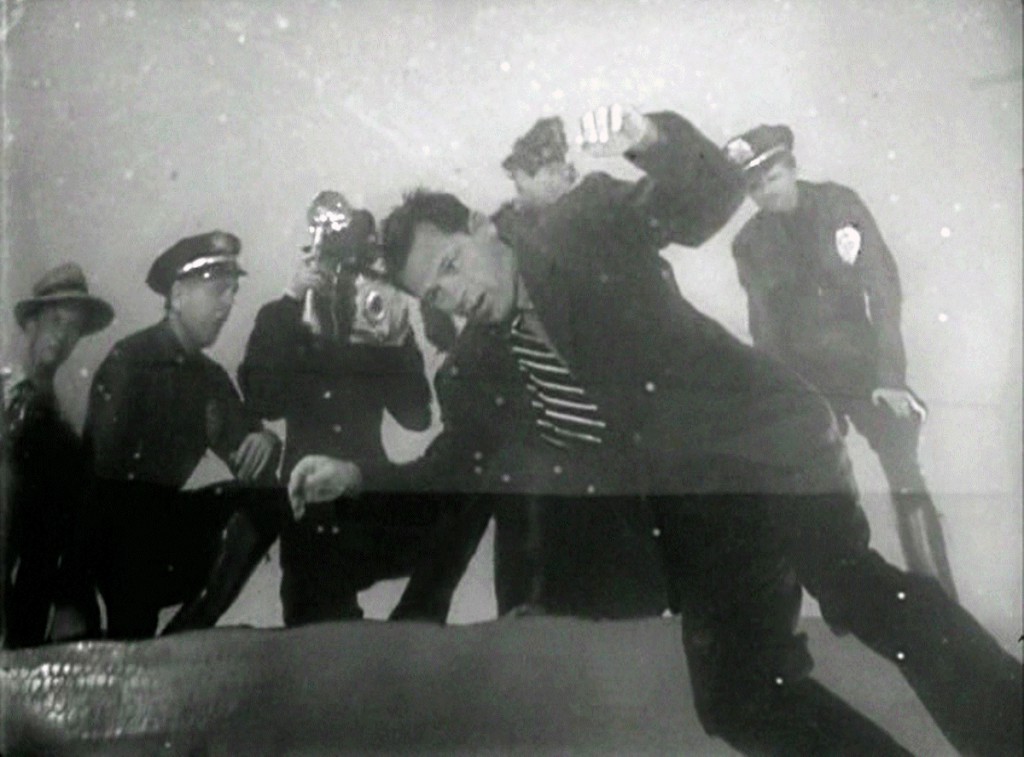
The opening shot of the movie shows Joe Gillis, the lead character, dead and floating up-side down in a swimming pool. He narrates his own story in the third person, Relating how the body of a young man was found in a movie star’s swimming pool early in the morning, He states that it was, “Nobody important really. Just a movie writer with a couple of ‘B’ pictures credit. The poor dope always wanted a pool. Well, in the end he got himself a pool —only the price was a little high.”
Filming the scene above was devised by art director John Meehan. Rather than using expensive underwater cameras, he placed a large mirror at the bottom of a process water tank. The film camera shot down from the edge of the “pool”and caught Holden, the cops and the others reflected in the mirror.
Joe Gillis switches to the first person narrative when earlier in his story he is still alive, typing out a screenplay in his crummy apartment on Ivar Street in Hollywood. He’s trying desperately to sell a screenplay to make some money to pay his next car loan payment, one step ahead of the car-repo men about to tail him. He goes to the Paramount studios to meet a producer. There he has no luck, especially when Betty Schaeffer, a script reader played by Nancy Olson, pans his script. He even asks the producer for a loan but gets nowhere. He goes to see his agent and asks for a loan from him and gets the brush-off. Soon he’s spotted by the repo-men and speeds down Sunset Blvd.
It’s by trying to outrun the car-repo men that Gillis ends up turning into a driveway off Sunset Boulevard and into an old garage, where the clues were mounting that he was entering into the Twilight Zone.
Inside was an old Isotta-Fraschini, the kind of car that one doesn’t drive, but is chauffeured in. “It must have burned up ten gallons to the mile,” narrates Gillis. Although this one needed some cleaning, the leopard-skin upholstery showed him that it was no ordinary car.
Joe Gillis thought he’d just leave his car there and skip town, giving up trying to make it as a script writer in Hollywood. But he thought he’d take a look at the mansion, figuring it had to be abandoned. “It was a a great big white elephant of a place. The kind crazy movie people built in the crazy Twenties,” he said. He compared it to Miss Haversham’s in Great Expectations.
The Twilight Zone beckons, as a woman calls out to him, imperiously asking why he has kept her waiting so long. Max the Butler calls him in, expecting an undertaker come to take care of the necessities for Madame’s deceased “pet” chimpanzee. It’s after a few minutes of wordplay and shock that Gillis begins to recognize the woman, after she wants to throw him out for not being the undertaker, and he delivers the line about “…you’re Norma Desmond…you used to be big.” And since this is really a film noir about Hollywood, everyone has a racket. She shows him her piles of manuscripts for her Salome “comeback,” he tells her he’s really an expensive scriptwriter that could polish up her sludge pile for $500 a week, and she starts to see a handsome live-in companion, and Max had it all figured out at hello.
Things are all cosy for a while, and Gillis slips into becoming a kept man. Only he starts sinking into the feeling of an age gone by. This is symbolized by Norma’s friends that come over for a bridge game, the “Wax works,” Gillis calls them. They are played by Buster Keaton, that genius of silent-film comedy, in 1950 not yet rediscovered, Then there’s H.B. Warner, who played Jesus Christ in the DeMille King of Kings in 1927, but in 1950 was more recognized as the drunk druggist Mr. Gower in It’s a Wonderful Life. And perhaps the most forgotten star of all, Anna Q. Nilsson, the first Swedish beauty of the silver screen, who started her motion picture career in 1911, and due to a severe accident had a long interruption, but resumed acting late culminating in Seven Brides for Seven Brothers.
Norma realizes she needs to start putting some spark in Joe’s life. Maybe a big New Year’s Eve party, with plenty of champagne and music, only with no guests so she can have Joe all for herself and tell him how much she needs him and loves him. Joe’s life flashes before his eyes and he tells Norma that he has a life of his own, and maybe even a girl he loves. Their disagreement ends in a slap, which convinces him to leave, and in rainy weather he goes to his friend Artie Green’s party, where he again sees Betty Schaeffer. She’s Artie’s girlfriend, but they have a strong attraction for each other. Joe plans to move in with Artie, making a call to Max saying he’ll collect his things in the morning. That’s when he finds out that Norma has tried to kill herself, and so he returns to the Mansion.
Norma perks up with his concern and return. Later with an unexpected but unanswered call from Paramount, she decides to visit the studio.The visit with Max driving them in the Isotta through the old main gates is classic. The worshipful reception of Norma/Gloria by the old-time studio hands and C.B. DeMille himself is a high-spot of the film. This element was added to the script after Billy Wilder witnessed for himself the reception Gloria Swanson received at the Paramount lot when filming of Sunset Blvd. began.
The visit to Paramount also provides an opportunity for Joe to visit the writer’s room, and there to see Betty Schaeffer again. They agree to work on a story together, for which Joe must get out of the mansion at night for their rendez-vous
One night Joe and Betty stroll through the “New York” set on the Paramount lot. Here she tells him about the nose job she got in order to land film roles. After that they liked her nose but not her acting,
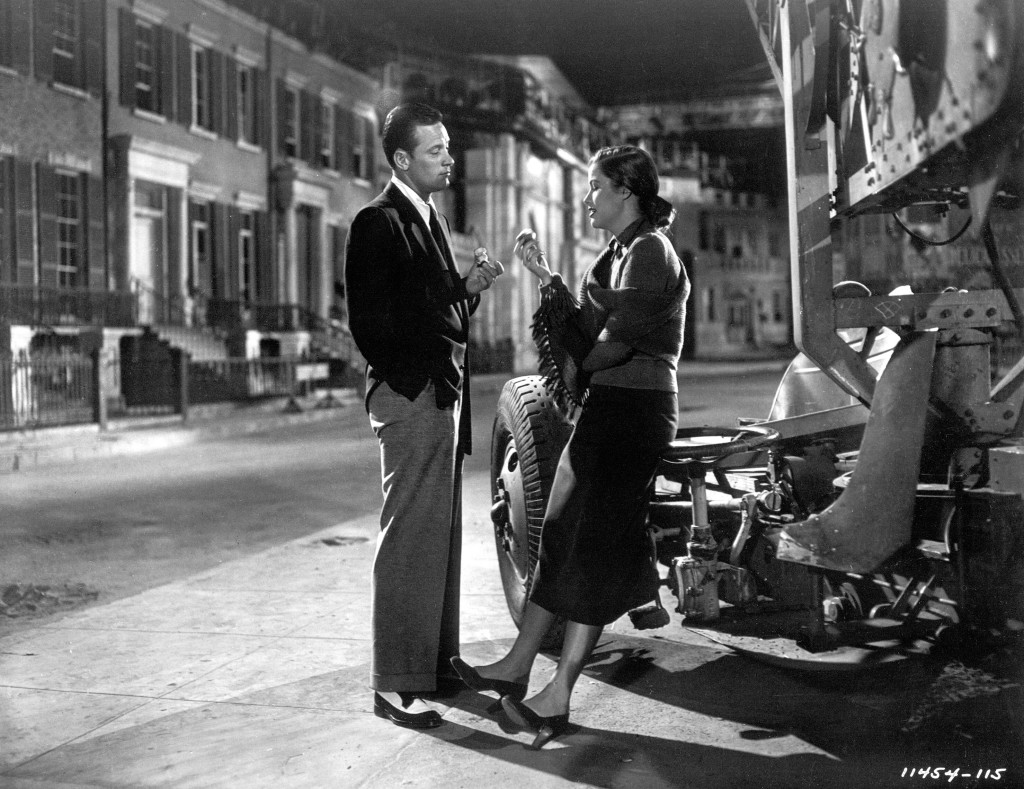
And of course they fall for each other. There is a great kissing scene on the 2nd story balcony of the old writer’s building. It was shot from a crane, with Billy Wilder and the cameraman at their level. Down below were the other crew members, among which was William Holden’s wife Ardis. As Nancy Olson related at the TCM Classic Film Festival screening of Sunset Blvd. in 2010, Billy Wilder told her and Holden that they should keep kissing until he told them to stop. He said he didn’t know how the scene would need to be edited. So they kissed, and kissed, and kissed some more. And they kept on kissing, until finally they heard a shout from down below , “cut goddammit!” It came from Ardis, Holden’s wife.
Things get serious between Joe and Betty, and they want to make plans, only this is a film noir, and we’ve already seen where it ends. Norma discovers their joint script one night and in jealousy phones Betty and spills about Joe’s situation. When Betty shows up at the mansion to see if it’s all true, there’s no hiding the rest of the story. That’s when Joe tells her he’s bound to Norma Desmond on a long term contract with no options. He escorts Betty out. Then tells Norma he’s leaving. As he gathers his things, leaving his eighteen suits and eighteen dozen shirts and platinum keychains she bought him, just packing his old things and typewriter, he tells her there will be no comeback movie for her at Paramount, that they only wanted her car, that Max was writing all her fan mail, and that no, he won’t stay. So she follows him, saying, “No one leaves a star,” and, “You’re not leaving me.” And as he makes his way towards the garage she shoots him – once – and twice more, as he falls into the pool.
Its early the next morning, and the film comes full circle, with police, photographers, the news, and all sorts of people hovering around. And there’s that pool again. The one Joe Gillis always wanted. He’s narrating his own story again, and now thy’re fishing him out of the pool. “Funny how gentle people get with you once you’re dead.” But as a writer, even a dead one, he almost had the last word on Norma Desmond: “What would they do to her? Even if she got away with it in court – crime of passion – temporary insanity – those headlines would kill her: Forgotten Star a Slayer –Aging Actress –Yesterday’s Glamour Queen…”
Inside, Max tricks her out of her bedroom by telling her the cameras are ready. Max at the bottom of the stairs, Are the lights ready? Quiet everybody! Are you ready Norma?
“What is the scene she asks?” “This is the staircase of the Palace,” says Max. “Camera. Action!” he says. She descends the staircase in a trance, At the bottom of the staircase she stops, too happy to continue with acting the scene, then asking an imaginary Mr. DeMille if she can say a few words, then saying,
“….You don’t know how much I’ve missed all of you. And I promise you I’ll never desert you again, because after ‘Salome’ we’ll make another picture and another. You see, this is my life. It always will be. There’s nothing else – just us and the cameras and those wonderful people out there in the the dark…All right Mr. DeMIlle, I’m ready for my closeup.”
And if you’ve seen it a million times like me you can hear Franz Waxman’s musical crescendo closing out the scene.
THE END
This last scene is the reason why Sunset Blvd is a masterpiece. Norma Desmond may have been considered a faded movie star, but she was a star and a performer to the end. She had lived the life of a movie queen and never gave up the role. She dressed up – never totally in style but always chic. Her fan mail may have been fake but that would not have changed her. She knew what she had accomplished, she was once and always a star. If she were around today she would be flocked by old movie fans. In this role Gloria Swanson had transcended the role and infused it with her own persona and her own glorious stardom. At a wrap screening for Paramount’s stars, it was said that Barbara Stanwyck wept as she kissed in reverence the hem of Gloria Swanson’s silver lame gown.
William Holden also makes this movie work. As co-star Nancy Olson stated at the TCM Film Festival in 2010, Holden made the movie during a personal dry spell, drinking heavily himself and facing the taste of desperation that breathed down Joe Gillis’s neck. Years later he stated that this was his favorite role. After Sunset Blvd., just like the principal star, Holden himself made a comeback. The film was ranked the 16th greatest of all-time by the American Film Institute, and the Library of Congress placed it in the National Film Registry as one of the 25 landmark films of all-time.
Edith Head designed the costumes for Sunset Blvd. When she had first started as a sketch artist at Paramount in 1923, Gloria Swanson was studio royalty. When Swanson returned from France after marrying the Marquis de la Falaise de la Coudraye, Edith Head was just one of the Paramount employees told to throw flowers as the couple drove onto the studio lot. Although Edith had now come a long way, she was still in awe of Gloria Swanson. This was especially the case as Swanson had always been a clothes-horse and very particular about her dress, and owning her own garment company. On her return from France in 1925, Swanson had also brought back fashion and costume designer Rene Hubert.
The look of Norma Desmond, and the role of the costumes in her characterization, was of someone that had only a hint of the old styles of Hollywood. She was certainly no Miss Haversham. She dressed smartly every day and wore clothes appropriate to the occasion and the time of day, even if she stayed mostly at home. When Joe Gillis first visits, she is wearing a hostess dress, a popular early 1950’s combination skirt and pants outfit.
Above is Miss Head’s costume sketch for Swanson’s opening scene as Norma Desmond. When you look closely you’ll notice in the movie, as in this design sketch, that the outfit has the pants worn under a hostess dress. The liner fabric was changed twice in the design phase, from the plaid fabric to a floral print and finally to the leopard print in the final production.
Edith designed a stylish ensemble that Norma wears for her Queen Kelly screening with Joe, shown as the first photo in this post. It is a brocaded top with a cut-away peplum, dropping lower at the back. it is worn over a simple black dress and top, accessorized with a beautiful over-sized necklace.
Above is Edith Head’s costume design sketch for Norma Desmond’s visit to the Paramount Studio and visit with Mr. De Mille. The final costume was modified. Gloria Swanson had always been fashion conscious. She suggested the feathered hat instead of the headpiece above as a way to emphasize her movie-role ties to an earlier Hollywood. Edith Head designed Swanson’s wardrobe for Norma Desmond as being someone still chic, but with a hint at her old glamour days. Below is the final costume used in the film’s Paramount studio visit.
For her final scene, Edith Head designed a simple costume for Norma’s Salome , a black gown with a sequined chiffon wrap, a hint of Gloria Swanson as the Salome of 1925 as seen below, back when they had faces.
*Idea originated in Sam Stagg Close-Up on Sunset Boulevard. New York: St Martin’s Pess, 2002.
Views: 735

